Two high-throughput screening assays for aberrant RNA-protein interactions in myotonic dystrophy type 1
- PMID: 22218462
- PMCID: PMC3280409
- DOI: 10.1007/s00216-011-5604-0
Two high-throughput screening assays for aberrant RNA-protein interactions in myotonic dystrophy type 1
Abstract
Myotonic dystrophy type 1 (DM1), the most prevalent form of adult muscular dystrophy, is caused by expansion of a CTG repeat in the 3' untranslated region of the DM protein kinase (DMPK) gene. The pathogenic effects of the CTG expansion arise from the deleterious effects of the mutant transcript. RNA with expanded CUG tracts alters the activities of several RNA binding proteins, including muscleblind-like 1 (MBNL1). MBNL1 becomes sequestered in nuclear foci in complex with the expanded CUG-repeat RNA. The resulting loss of MBNL1 activity causes misregulated alternative splicing of multiple genes, leading to symptoms of DM1. The binding interaction between MBNL1 and mutant RNA could be a key step in the pathogenesis of DM1 and serves as a potential target for therapeutic intervention. We have developed two high-throughput screens suitable assays using both homogenous time-resolved fluorescence energy transfer and AlphaScreen technologies to detect the binding of a C-terminally His-tagged MBNL1 and a biotinylated (CUG)(12) RNA. These assays are homogenous and successfully miniaturized to 1,536-well plate format. Both assays were validated and show robust signal-to-basal ratios and Z' factors.
Figures





Similar articles
-
High-throughput kinome-RNAi screen identifies protein kinase R activator (PACT) as a novel genetic modifier of CUG foci integrity in myotonic dystrophy type 1 (DM1).PLoS One. 2021 Sep 14;16(9):e0256276. doi: 10.1371/journal.pone.0256276. eCollection 2021. PLoS One. 2021. PMID: 34520479 Free PMC article.
-
Colocalization of muscleblind with RNA foci is separable from mis-regulation of alternative splicing in myotonic dystrophy.J Cell Sci. 2005 Jul 1;118(Pt 13):2923-33. doi: 10.1242/jcs.02404. Epub 2005 Jun 16. J Cell Sci. 2005. PMID: 15961406
-
Fuchs' Endothelial Corneal Dystrophy and RNA Foci in Patients With Myotonic Dystrophy.Invest Ophthalmol Vis Sci. 2017 Sep 1;58(11):4579-4585. doi: 10.1167/iovs.17-22350. Invest Ophthalmol Vis Sci. 2017. PMID: 28886202 Free PMC article.
-
Pathogenic mechanisms of myotonic dystrophy.Biochem Soc Trans. 2009 Dec;37(Pt 6):1281-6. doi: 10.1042/BST0371281. Biochem Soc Trans. 2009. PMID: 19909263 Free PMC article. Review.
-
Gain of RNA function in pathological cases: Focus on myotonic dystrophy.Biochimie. 2011 Nov;93(11):2006-12. doi: 10.1016/j.biochi.2011.06.028. Epub 2011 Jul 13. Biochimie. 2011. PMID: 21763392 Review.
Cited by
-
Covalent small-molecule-RNA complex formation enables cellular profiling of small-molecule-RNA interactions.Angew Chem Int Ed Engl. 2013 Sep 16;52(38):10010-3. doi: 10.1002/anie.201301639. Epub 2013 Aug 1. Angew Chem Int Ed Engl. 2013. PMID: 23913698 Free PMC article.
-
Precise small-molecule recognition of a toxic CUG RNA repeat expansion.Nat Chem Biol. 2017 Feb;13(2):188-193. doi: 10.1038/nchembio.2251. Epub 2016 Dec 12. Nat Chem Biol. 2017. PMID: 27941760 Free PMC article.
-
Design of novel small molecule base-pair recognizers of toxic CUG RNA transcripts characteristics of DM1.Comput Struct Biotechnol J. 2020 Dec 6;19:51-61. doi: 10.1016/j.csbj.2020.11.053. eCollection 2021. Comput Struct Biotechnol J. 2020. PMID: 33363709 Free PMC article.
-
Grand canonical Monte Carlo and deep learning assisted enhanced sampling to characterize the distribution of Mg2+ and influence of the Drude polarizable force field on the stability of folded states of the twister ribozyme.J Chem Phys. 2024 Dec 14;161(22):225102. doi: 10.1063/5.0241246. J Chem Phys. 2024. PMID: 39665326
-
A Druglike Small Molecule that Targets r(CCUG) Repeats in Myotonic Dystrophy Type 2 Facilitates Degradation by RNA Quality Control Pathways.J Med Chem. 2021 Jun 24;64(12):8474-8485. doi: 10.1021/acs.jmedchem.1c00414. Epub 2021 Jun 8. J Med Chem. 2021. PMID: 34101465 Free PMC article.
References
-
- Aït-Aïssa S, Porcher J-M, Arrigo AP, Lambrè C. Activation of the hsp70 promoter by environmental inorganic and organic chemicals: relationships with cytotoxicity and lipophilicity. Toxicology. 2000;145(2-3):147–157. - PubMed
-
- ASTM Standard guide for acute toxicity test with the rotifer. Brachionus. 2004:1440–91.
-
- Auboeuf D, Rieusset J, Fajas L, Vallier P, Frering V, Riou JP, Staels B, Auwerx J, Laville M, Vidal H. Tissue distribution and quantification of the expression of mRNAs of peroxisome proloferator-activated receptors and liver X receptor-alpha in humans: no alteration in adipose tissue of obese and NIDDM patients. Diabetes. 1997;46(8):1319–1327. - PubMed
-
- Baker ME, Ruggeri B, Sprague J, Eckhardt C, Lapira J, Wick I, Soverchia L, Ubaldi M, Polzonetti-Magni AM, Vidal-Dorsch D, Bay S, Gully JR, Reyes JA, Kelley KM, Schlenk D, Breen EC, Sásik R, Hardiman G. Analysis of endocrine disruption in southern California coastal fish using an aquatic multi-species microarray. Environ. Health Perspect. 2009;117(2):223–230. - PMC - PubMed
-
- Bay S, Berry W, Chapman P, Fairey R, Gries T, Long ER, McDonald D, Weisberg SB. Evaluating consistency of best professional judgment in the application of a multiple lines of evidence sediment quality triad. Integrated Environmental Assessment and Management. 2007;3:491–497. - PubMed
Publication types
MeSH terms
Substances
Grants and funding
LinkOut - more resources
Full Text Sources
Other Literature Sources

